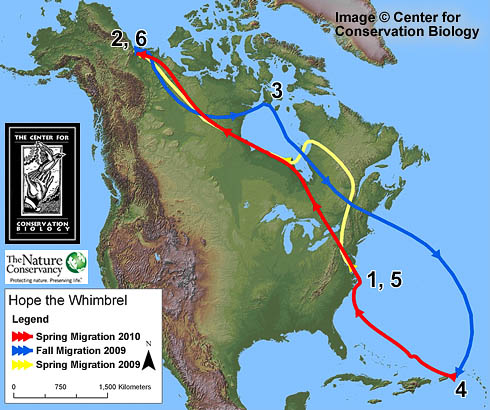Hope the whimbrel returns
How Do I Get Out Of This Egg?
March 5, 2010Azalea Has Returned to Mattamuskeet NWR
March 6, 2010
Written by Bryan Watts & Fletcher Smith
March 5, 2010

Tagged and transmittered whimbrel on the Eastern Shore of Virginia. Photo by Barry Truitt.
Hope, a whimbrel carrying a satellite transmitter, followed the same track to breeding grounds in the Northwest Territories as she did in 2009, via the Eastern Shore of Virginia. Her amazing year-long odyssey recorded by shorebird researchers is confirming how much of the species’ life cycle is dependent on specific staging sites and that their migrations are surprisingly structured. Hope wintered on St. Croix in the U.S. Virgin Islands from 14 August 2009, where she was observed foraging on Great Pond, a Birdlife International Important Bird Area, until the evening of 9 April 2010, flying east of Puerto Rico and northwest over the open ocean for nearly 1,500 miles (2,400 kilometers). The bird came near land around Cape Lookout and then followed the shoreline around the Outer Banks of North Carolina and up to the lower Delmarva Peninsula, making landfall around 3:15 in the afternoon of 11 April 2010. The trip covered approximately 1,660 miles (2,678 kilometers) in less than 2 days. Hope settled on the same marsh where she was captured by CCB biologists in the spring of 2009. Hope left this staging area on the Eastern Shore of Virginia on May 22 2010 and flew the 12-day, 3149 mile journey to the Northwest Territories, Canada, arriving on 4 June 2010, having stopped briefly along the coast of the Hudson Bay.

1) 5/26/09 Eastern Shore, VA 2) 6/22/09 Northwest Territories, CANADA 3) 7/16/09 Southampton Island 4) 8/14/09 US Virgin Islands 5) 4/12/10 Eastern Shore of VA 6) 6/4/10 Northwest Territories, CANADA. Map by the Center for Conservation Biology.
Hope was originally captured and fitted with a satellite transmitter on 19 May, 2009 while stopping over on the Delmarva Peninsula of Virginia. In 2009, she left Virginia on May 26 and flew to the western shore of James Bay in Canada. She staged on James Bay for 3 weeks before flying to the MacKenzie River near Alaska and then on to the Beaufort Sea, where she staged for more than 2 weeks before flying back to Hudson Bay. Hope then staged on South Hampton Island in upper Hudson Bay for 3 weeks before leaving on a non-stop flight of more than 3,500 miles (5,630 kilometers) over the open Atlantic to St. Croix where she spent the winter months. In less than one year, this bird has travelled more than 17,319 miles (22,800 kilometers).

Whimbrels near a marsh on the Eastern Shore of Virginia. Photo by Barry Truitt.
Hope is one of several birds that have been fitted with state of the art 9.5-gram, satellite transmitters in a collaborative effort by the Center for Conservation Biology at the College of William and Mary – Virginia Commonwealth University and the Virginia chapter of The Nature Conservancy to discover migratory routes that connect breeding and winter areas and to identify en route migratory staging areas that are critical to the conservation of this declining species.

Whimbrel wearing custom-fitted satellite transmitter. Photo by the Center for Conservation Biology.
Satellite tracking represents only one aspect of a broader, integrated investigation of whimbrel migration. During the past 2 years, the Center for Conservation Biology in partnership with the Nature Conservancy has used conventional transmitters to examine stopover duration, conducted aerial surveys to estimate seasonal numbers, collected feather samples to locate summer and winter areas through stable-isotope analysis, and has initiated a whimbrel watch program. Continued research is planned to further link populations across staging, breeding, and wintering areas and to determine the ecological requirements of whimbrels staging along the peninsula.
Funding has been provided by the Center for Conservation Biology (CCB), The Nature Conservancy (TNC), U.S. Fish and Wildlife Service (USFWS), the Virginia Coastal Zone Management Program (CZM), and the Northern Neck Audubon Society.



